Cowan 5
The development of technology is not always based on science.
- it can be based on craft
knowledge rather than science
- science is a specific
kind of knowledge--scientific laws, not just ordinary
experience
- I'm interested in what
the person doing the development actually knows and uses
- can you draw a clear
line between technology and science?
- technology changes the
environment (invention), science is knowledge about how
the universe works (discovery)
- in recent years
some science and some technology have come
together--the two circles have begun to overlap (Cowan
calls that techno-science)
In order to have factories, there needed to
be better transportation to distribute factory-made goods over
a wide area
- again England took the lead
- the technologies were
copied in the United States
- U.S. conditions were
different particularly because the distances were much
greater
In all of these industrial revolution topics look at how
technology came from England to the U.S. and had to be adapted
to meet American conditions
Transportation technology in England:
- improved roads built in large numbers
1750-1815 (about 1000 miles), reduced transportation costs
20-30%
- Canals
- The
Duke of Bridgewater's Canal started in 1759--7
miles but had to cross a river valley. People
thought this was a wild dream, but built
in 5 years. Very profitable--halved the cost of
coal
in Manchester
- canal building boom 1750-1800--by 1830
England had 3875 miles of navigable water (though only
1/3 of that was canals). The Oxford canal paid a
30% return for 30 years.
- provided much cheaper transportation
of bulky goods

canals in Birmingham
- railroad in England:
- locomotives tried in coal mines first,
but were generally too heavy for existing tracks used
by horse-drawn cars
- 1825 Stockton
and
Darlington Railroad was first common carrier to
use locomotives
- in 1829 the Liverpool and Manchester
had a contest to test locomotives. Thousands of
people came to watch. Won by the Rocket designed
by Robert Stephenson.

1829 Rocket
Now consider how
things were different in the United States:
Transportation was
essential to economic development, and the need became more
critical with westward expansion. Factories might be
considered undemocratic, but there was no doubt that you needed
roads to unify the 13 colonies into a nation. Note
particularly how transportation technology was adapted to meet
American conditions.
Turnpikes in the U.S.:
- First turnpikes (improved toll road) in the
United States in Pennsylvania
and Virginia in 1795. 1796-1814 Mass. chartered 97
turnpike companies.
- in 1775 it took a week to go from Boston to
New York by land, in 1800 it took four days.
- cleared and leveled land, built simple wooden
bridges (even floating bridges to cross deep ponds).
Large rivers were crossed by ferry.
- 1785 bridge over the Connecticut at
Bellows Falls--wooden covered bridge 365 feet, 50 feet
above river--build by a simple carpenter.
- Bridges longer than a single stringer were
built first with arches then with trusses--Burr
Truss was one American innovation that combined the
two.
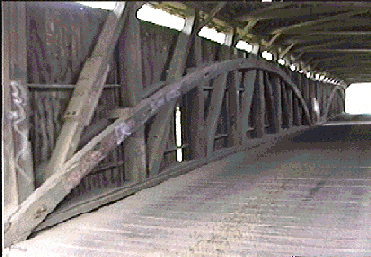
A Burr Truss
Covered Bridge
Canals in the U.S.:
- Many proposals for canals in late 18th century
America
- First canal completed was the Santee
Canal in 1800, connecting Charleston with Columbia
- the person who knew how to built a canal was
Christian
Senf: came from Europe during the American revolution
as a Hessian mercenary with knowledge of military
engineering
- With a couple of
exceptions developed to meet military needs, there were no
engineering schools until the 1860s--the expertise to build canals did not exist except
for mill races and a few short canals around rapids.
- Such engineering as
there was learned by apprenticeship, and there was not a
clear distinction between an engineer and a mechanic.
Most engineers were entrepreneurs, not employees of larger
businesses (there weren't yet any large businesses until the
railroads)
- Bridges were built by
the local carpenter, and the canals built for water-powered
grain mills or to carry boats short distances around rapids
did not use much technology. They were often built with
local businessmen or civic leaders (the first canal on the
Merrimack at Amoskeag was build by a judge of common pleas)
who had no experience.
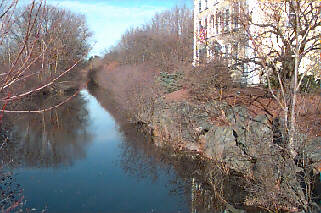
The Middlesex canal--27
miles joining the Charles River with the junction of the Concord
and Merrimack, with 20 locks, 8 aqueducts, and 48 bridges.
Map
, History, Visitor
Center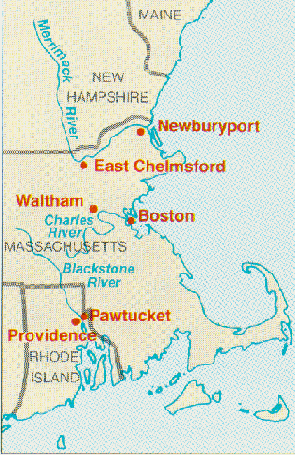
- Chartered in 1793
by Boston merchants who wanted to bring more trade through
Boston. Director: Loammi Baldwin, a retired
colonel who dabbled in cabinetmaking, surveying and
experimentation and had a Harvard-education in Latin and
Greek.
- A local surveyor and
magistrate, Samuel Thompson, set out to survey the route,
using a compass, his eye, and his best judgment. In
one 6 mile stretch he measured the route with a rise of 16
1/2 feet. A later survey turned up a descent of 25
feet.
- You can't build a major
canal without specialized knowledge
- They had only simple
tools: axes, hoes, shovels, mattocks, crowbars, scythes,
and pitchforks, cold chisels for cutting stone.
- They did not know
how to excavate efficiently, how to seal the canal so
that it would not leak, or what was the best shape for
retaining walls and the best material for locks.
- They did not know
how to make mortar that would hold under water or how to
design the machinery to open and close the valve gates
of the locks.
- They needed an expert.
In
1793 they hired William Weston, an experienced Englishman
who had recently come to America to supervise the
construction of a canal in Philadelphia.
- He agreed to come to
Boston in the summer of 1794 because the Philadelphia
project had run out of money. For six weeks work
and travel time he was paid $2107.60.
- sent in advance the
key instruments--a spade, an improved wheelbarrow, and
his own leveling instrument
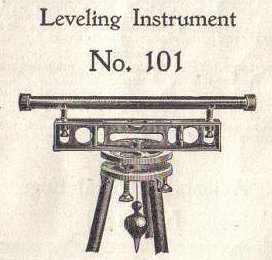
- The wheelbarrow got lost
in transit, and no one could figure out how to use the
leveling instrument until Weston arrived himself.
- When he arrived he did
the necessary surveying and taught the locals how to solve
their problems--taught them the specialized knowledge of
canal engineers
- sealing the canal by
puddling with clay in many thin layers
- he arranged for
machinery for the lock gates to be cast in a foundry in
New York from molds he made himself
- The Middlesex canal was
finally successfully completed in 1803 at a total cost of
$1,164,200. It was a moderate financial success, but,
more important, the investors profited by increased trade
through Boston. "The trip to New Hampshire took five
days, and passage back to Charlestown took four days, and
while the cost of carrying goods from Boston by a team of
oxen was $20 per ton, the rate of boating freight on the
canal cost from $5 to $13."
- Three people who worked
with Weston went on the be successful canal engineers:
Loammi Baldwin's son Loammi
Baldwin
Jr., Benjamin Wright, and Robert Brooke

Middlesex Canal
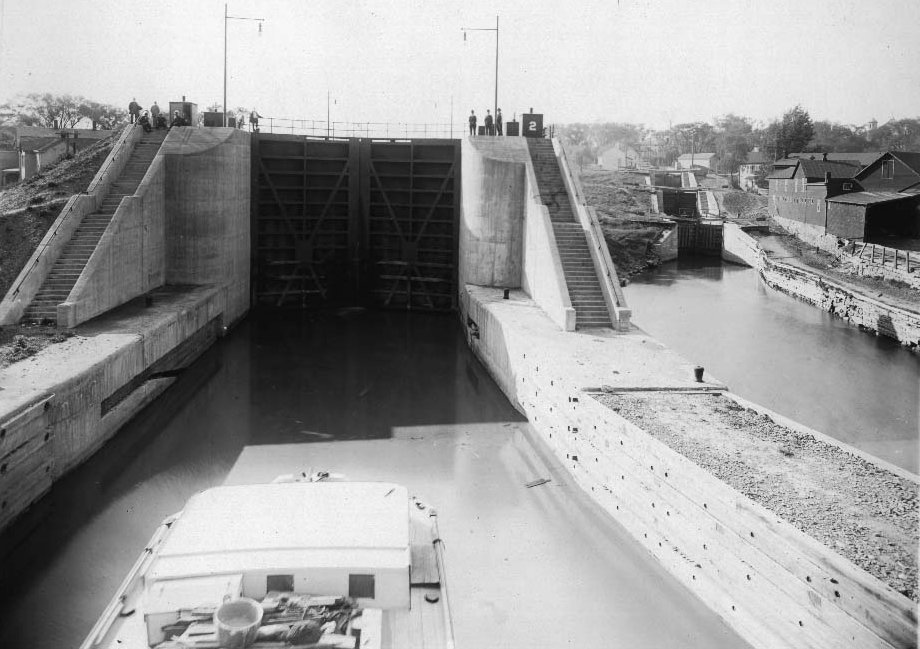
A similar story could be told
about the Erie canal.
- Planning for the Erie
canal began about 1804, construction authorized in 1816
after much unskilled study.
- Completed in 1825--at
363 miles the longest canal in the world.
- Also a major source of engineering
training--by 1825 all but one principal engineer had
worked their way up in the canal system and at least 11 of
the 24 principal engineers went on to other engineering
work.
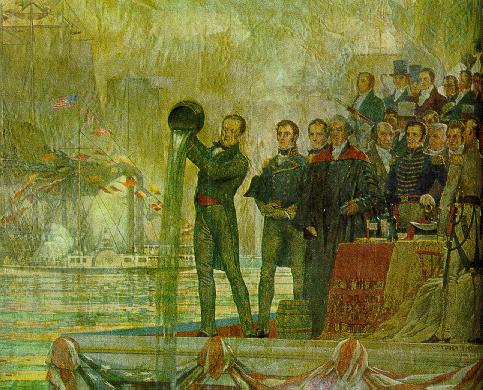
Celebration of the Completion of the Erie Canal
Steam Boats in the U.S.
- experiments as early as 1780s both in
England and American, but the need was greater in America.
- a lot of varied speculation, including an 1785
paper by Benjamin Franklin in which he concluded that
paddlewheels were inefficient and proposed jet propulsion.
- This put John Fitch on the wrong track--his
mechanic convinced him not to try water jets but he worked on
crank and paddles
instead of paddle wheels. he did demonstrate a boat in
1787 and run boats on the Mississippi in a commercial
operation as early as 1790, although he ultimately failed.
- Robert Fulton trained in England and France
(he had gone to London originally to study art but ended up
studying civil engineering). He built his first
commercially successful steamboat for the Hudson starting
operation in 1807 (with a promise of a 20 year monopoly from
the NY legislature) with a 133 ft. boat called the Clermont
with twin sidewheels. He used a
Watt engine and built his boats for passenger comfort and
speed.
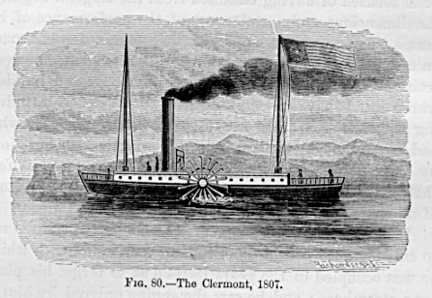
The Clermont, from an 1878 history of steam power by
Thurston
- He also ran boats on the Mississippi, but they
didn't do very well.
- Other engineers solved the problems of
adaptation of the steam boat to western
conditions .
- The key innovation was the high-pressure steam
engine invented by Oliver Evans in 1801. Dominated
western steamboats because less fouled by muddy water.
- Gradual development of shallow hull and flat
bottom, upper decks, horizontal engine (easier to connect to a
stern paddlewheel. Model
- Extremely profitable--sometimes 100% a
trip. Henry Shreve did the best job of putting all these
innovation together and also invented the snagboat
. clearing
snags
- The steam boat was the first time the United
States took the lead in developing a major new technology
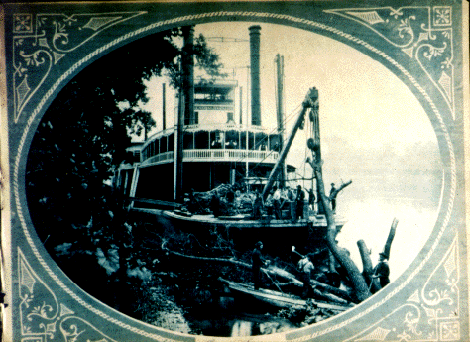
removing snags
The railroad in the U.S.:
- started with short horse-drawn lines--eg.
Granite Railroad, Quincy, Mass., 2 miles long, also in coal
mines

Best
Friend of Charleston, 1830
- From Charleston to Hamburg on the Savannah
River--136 miles opened in 1833. The South Carolina
Canal and Rail-Road Company hired an engineer names Horatio
Allen who not only built the first domestic-built locomotive,
The Best Friend of Charleston , but also was a pioneer in the
1830s in adapting locomotive design to American conditions by
inventing the swivel truck.
- the railroad met a tremendous need and grew
quickly
total mileage in the United States:
|
|
1830 |
1840 |
1850 |
1860 |
1870 |
| canals |
1277 |
3326 |
3698 |
|
|
| railroad |
73 |
3328 |
8879 |
30,636 |
50,000 |
Adapting the railroad to American conditions:
started with the problem that English locomotives
were too heavy and rigid--distances were long, iron track was
expensive. Inventions concentrated on the problem of
cost/mile
- wooden ties in loose gravel instead of granite
blocks
- T-rail--requires less iron and skilled labor
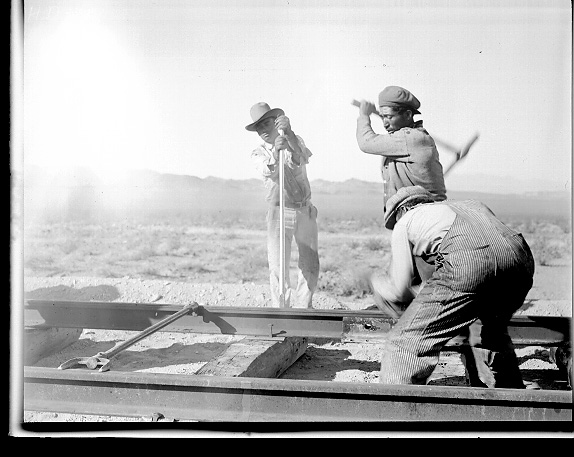
railroad construction (image HD217)
- equalizing lever suspension (1839) to prevent
damage on rough roadbeds
- swivel truck--jointed locomotive for sharp
curves
- engines that burned anthracite (though wood
lasted a long time)
- cowcatcher--because roads were not walled
off. Isaac Dripps first design impaled the cow on
prongs--difficulty of extricating the cow alive led to design
to sweep the cow aside
- gauge standardized by law in 1863--30 years
after England. Issue of states rights but also Erie
Railroad deliberately chose 6 ft. gauge to prevent diversion
of traffic
- standard time 1883
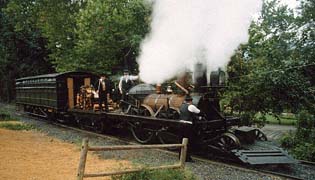
The John
Bull, imported in 1831
Government helped with the huge expense.
- State charters gave privileges of eminent
domain, sometimes monopoly, no taxes--about 20% of railroad
capital came from state purchase of stock and loans
- Many projects failed, eg. Stumphouse Tunnel
north of Walhalla
- Federal congress started early debating land
grants for a transcontinental
railroad --debates over the constitution and sectional
jealousies over the route.
- In 1850 there was a federal land grant for a
railroad from Illinois to Alabama, but the transcontinental
railroad was blocked by route partisans until the civil war.
- 1862 Pacific Railway act set a route from
Omaha Nebraska to Sacramento Calif, completed May 10, 1869 . Other
routes in 1880s.
The railroad brought modern management and a
national market. These led to big
business and consumer culture.
A timeline of
railway history













